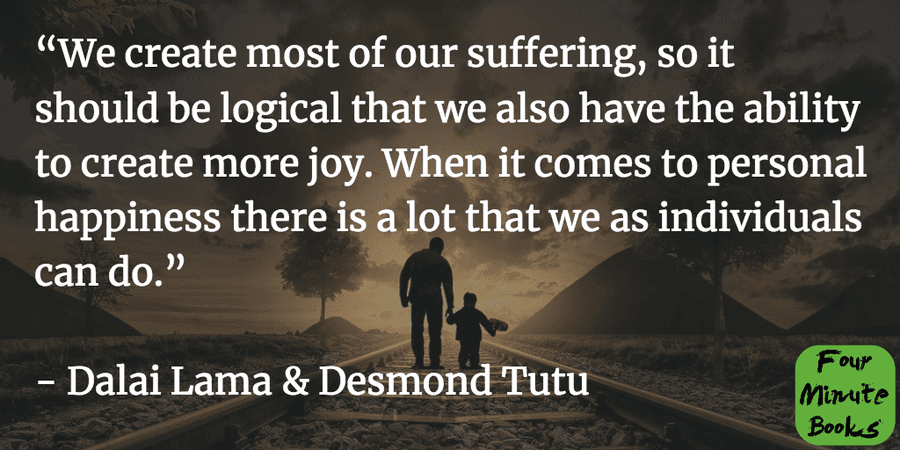The Book Of Joy Summary
Curated from: fourminutebooks.com
Ideas, facts & insights covering these topics:
13 ideas
·2.92K reads
24
Explore the World's Best Ideas
Join today and uncover 100+ curated journeys from 50+ topics. Unlock access to our mobile app with extensive features.
The Book Of Joy - Summary
In 2015, Desmond Tutu , a former South African Archbishop and anti-apartheid pioneer, traveled to Dharamsala, a place in India and home to His Holiness the Dalai Lama , for his 80th birthday. Both have fought non-violently against oppression in their countries for over 50 years, while leading millions of people in their spiritual journeys. Hence, they took this special occasion as a chance to sit down together and evaluate one of life’s most important questions: how do we find joy in the face of suffering?
18
289 reads
Indeed, a long sit-down it was. Tutu stayed for seven days, during which he and the Dalai Lama intensely discussed this issue. Douglas Abrams, Tutu’s long-time co-writer and editor, documented the conversation, so that one year later, their answers would be available to the rest of the world in the form of a book, The Book Of Joy .
19
264 reads
Quote
"We create most of our suffering, so it should be logical that we also have the ability to create more joy. When it comes to personal happiness there is a lot that we as individuals can do."
-Dalai Lama & Desmond Tutu
26
316 reads
Top 3 Lessons
While the two addressed many obstacles to joy, along with eight pillars that enable it, I’d like to use the following 3 lessons to address the root issue and how to move past it:
- A life without suffering does not exist.
- Since we can’t control suffering, we must practice our response to it.
- Compassion and sadness help us alleviate our troublesome responses to suffering.
27
280 reads
Lesson 1: There is no life without suffering.
Especially in the Western world, we are constantly being sold on the idea that it’s possible to remove all suffering from your life. There’s a pill for every ill, money solves most problems, and once you finally have that spouse, the home and the two kids, you’ll be happy forever.
But, speaking of kids, how do they arrive in this world? Through an excruciating process called giving birth. If women didn’t power through it in exchange for the bundles of joy kids are, the human race could pack it in right now!
21
230 reads
Birth is just the most obvious example, however. If you think back to your most formative experiences, chances are there was some anger, frustration or sadness involved, which ultimately helped you grow tremendously.
The Dalai Lama and Desmond Tutu agreed on the importance of suffering, but only if you experience it in a special way: while suffering, you must shift your focus away from yourself and on to others . This is one of the four big thoughts in Lojong , the Buddhist mind training practice the Dalai Lama preaches, which consists of 59 slogans.
22
225 reads
Focusing intensely on your own pain only makes it grow, while looking to others helps you deal with it in two ways:
- If you go out of your way to help someone, you forget about your own problems and feel better, because you’re doing good.
- You’ll often see that someone else has it a lot worse than you do.
20
221 reads
For example, the Dalai Lama once had to cancel giving a talk and go to the hospital with severe stomach pains. On the way to the clinic, he saw a sick, old man on the street. Knowing the man would probably soon die and feeling his agony, it was easier for him to muscle through.
There was nothing he could have done, but at least he turned the man’s suffering into a small force for good. So you see, it’s not about being a saint, it’s about managing suffering in the best way possible.
18
195 reads
Lesson 2: You don’t always control suffering, but you always control your response to it.
Self-awareness helps a lot when dealing with suffering, because it allows you to see what you control and what you cannot influence. A lot of pain is inflicted upon us externally, for example through unlucky events, natural disasters, sicknesses, or bad things that happen to people close to us.
While you can’t prevent these darker aspects of life, there is a corresponding element you do control: your reaction to those events.
22
190 reads
While you can’t prevent these darker aspects of life, there is a corresponding element you do control: your reaction to those events. Suffering often leads to fear and frustration, but those are creations of our minds, not reality, as the Dalai Lama and Desmond Tutu agree . Mental immunity , as they call it, is the equivalent of a healthy immune system: you’ll still feel pain, but you’ll be able to ward it off a lot better.
For example, when you treat a traffic jam as an opportunity to practice patience, rather than fretting about whether you’ll make it on time, you’ll be a lot less stressed.
22
171 reads
Lesson 3: Compassion and sadness are channels to let go of the anger and stress that result from suffering.
Whether the source of our suffering is internal or external, it is often the result of us having had expectations that didn’t end up matching reality. We don’t expect traffic jams, deadly diseases, or price increases at the grocery store, so reality “fails” us and we become stressed and angry. The end result is, once again, fear.
To turn this fear into joy, or at least not let it overtake, you can channel stress and anger into compassion and sadness, which are two much more productive feelings .
20
184 reads
Whether you’re compassionate with yourself and let yourself off the hook, or someone else holds your hand and tells you that things will be okay, it’s a powerful way of immediately dissolving anger.
As for sadness, it is an emotion that allows us to reflect and process bad events , which we can use to then take positive action, for example by honoring the dead and their legacy, living in ways that would make them proud, and helping others do the same.
21
169 reads
The Book Of Joy - Review
I know The Book Of Joy isn’t the most actionable book in the world, because it’s hard to practice feelings, but I believe it all starts with education. Learn the process of turning suffering into joy, let it sink in, and re-visit it often to become better at it. As these two leaders know: it’s a lifelong procedure, but one well worth pursuing.
19
186 reads
IDEAS CURATED BY
CURATOR'S NOTE
The Book of Joy - Summary
“
Tom Joad's ideas are part of this journey:
Learn more about philosophy with this collection
How to strengthen your willpower
How to overcome temptation and distractions
The role of motivation in willpower
Related collections
Similar ideas
11 ideas
The Art Of Happiness Summary
fourminutebooks.com
13 ideas
As A Man Thinketh Summary
fourminutebooks.com
11 ideas
Emotional Intelligence 2.0 - Book Summary
journeywithlyv.wordpress.com
Read & Learn
20x Faster
without
deepstash
with
deepstash
with
deepstash
Personalized microlearning
—
100+ Learning Journeys
—
Access to 200,000+ ideas
—
Access to the mobile app
—
Unlimited idea saving
—
—
Unlimited history
—
—
Unlimited listening to ideas
—
—
Downloading & offline access
—
—
Supercharge your mind with one idea per day
Enter your email and spend 1 minute every day to learn something new.
I agree to receive email updates

